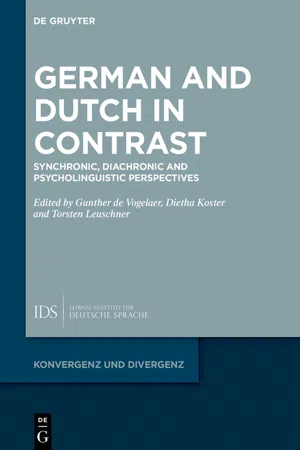Nickname formation in West Germanic: German Jessi and Thomson meet Dutch Jess and Tommie and English J-Bo and Tommo
Abstract: German, Dutch, and English nickname formation is examined using a contrastive corpus of nicknames which were found in the online profiles of amateur athletes and are compared with the same individuals’ first and last names. We study the word formation and word creation of nicknames, either based on the athletes’ legal names or coined freely, pointing out parallels and divergences between the three languages. Two prototypes are identified crosslinguistically as relevant bases for output schemas: disyllabic trochees ending in -i (cf. German Conni, Dutch Passie, English Thanny) and monosyllabics ending in a closed syllable containing a single sonorant (Sash, Bous, Maze). These structures are then interpreted in terms of preferred sound patterns and sex marking. Dutch turns out in many respects to hold an intermediate position between German and English.
Zusammenfassung: Anhand kontrastiver Daten zum Deutschen, Niederländischen und Englischen wird der Bildung von Spitznamen nachgegangen. Grundlage des Korpus sind Spitznamen von Amateursportlerinnen und -sportlern, die internetbasiert anhand von Steckbriefen erhoben wurden und mit den Ruf- und Familiennamen der betreffenden Personen abgeglichen werden. Anhand der Wortbildungen und -schöpfungen auf Basis der offiziellen Namen sowie der freien Schöpfungen werden Parallelen und Divergenzen von Spitznamen in den drei Sprachen herausgearbeitet. Zwei Prototypen werden sprachübergreifend als Grundlage von Output-Schemata identifiziert: zweisilbige, trochäische Namen auf -i (vgl. dt. Conni, nl. Passie, engl. Thanny) sowie Einsilber auf geschlossene Silbe mit einfachem Sibilanten (Sash, Bous, Maze). Die Daten werden in Hinblick auf Lautstrukturpräferenzen und Geschlechterkennzeichnung interpretiert. Das Niederländische nimmt dabei in vielerlei Hinsicht eine mittlere Stellung zwischen Deutsch und Englisch ein.
1Introduction
In addition to a legal name, people usually bear a couple of unofficial names, some of which may be characterized as nicknames.1 In this chapter, we examine personal nicknames based on first names such as German Jessi < Jessica or Thomson < Thomas, and nicknames based on last names such as Dutch Hoegie < Hoegarts, Siem < Simons. We also consider freely coined nicknames, cf. English Ders, Loofa.
The objective of this chapter is to identify parallels and divergences in the formation of nicknames in three closely related West Germanic languages, viz. German (G.), Dutch (D.), and English (E.), based on a comparable set of data. The data stems from amateur athletes’ internet profiles and was gathered analogously for the three languages. We compare the data in terms of the broad variation and the distribution of frequencies where the patterns observed in nickname formation are concerned.
As the examples in the title show, different kinds of nicknames are formed based on first names. G. Jessi and Thomson, D. Jess and Tommie, and E. J-Bo and Tommo are all based on Jessica (in the case of J-Bo also integrating the beginning of the last name Bowden) and Thomas or Tom, respectively. There is thus variation in the formation of nicknames between these languages. However, most of these forms could just as likely stem from the other two languages, thereby indicating parallels between them as well.
Our knowledge of nicknames differs between the three languages: While monograph studies and other publications exist regarding G. (cf. Kany 1992; Naumann 1976, 1977) and E. (cf. Morgan/O’Neill/Harré 1979; Busse 1983; de Klerk/ Bosch 1996, 1997; Starks/Leech/Willoughby 2012), our main insights into D. stem from studies on specific dialects (cf. Leys 1968; Mennen 1994; Van Langendonck 1978), while no systematic studies on Standard Dutch have been found. The present study seeks to tackle this deficiency. At the same time, contrastive studies of nicknames are rare, and we therefore wish to provide new information on nicknames in the three languages and their current relation from a contrastive perspective. We focus entirely on phonological and morphological aspects, since these have proven particularly relevant in earlier studies (cf. Naumann 1976, 1977 for G.; Taylor-Leech/Starks/Willoughby 2015 for E.).
2Nicknames: definitions and characteristics
Nicknames are usually defined as being a) bound to an individual in addition to her or his legal name, b) specific to a certain group of people with which an individual regularly interacts (e.g., a school class, a sports team, a choir, etc.), c) not suitable for legal or outsider use, and d) usually chosen by other people, i.e., not self-given (cf. Nübling/Fahlbusch/Heuser 2015: 171–172). Apart from these main characteristics, no consensus has been reached for the definition of nicknames (cf. Brylla’s 2016 handbook chapter discussing the lack of a common terminology in Germanic linguistics and even within the linguistics of specific Germanic languages). In certain definitions, for instance, the use of the term nickname is restricted to bynames, which usually stem from the lexicon and are based on a relation to the name bearer’s person, physique, lifestyle, etc. (e.g., Smiley, Angry), while formations based on the individual’s legal name are regarded as so-called pet names.2 Other definitions offer different categories. Lawson (1973) separates so-called short names (such as Dave < David) from what he calls nicknames with an affective suffix (such as Davey), and corroborates this separation by asserting that different stereotypes of the two types of names exist: While most short names are associated with positive values (‘good’, ‘active’, ‘strong’) even more than the corresponding full forms, the derived nicknames are rated comparatively low according to...

